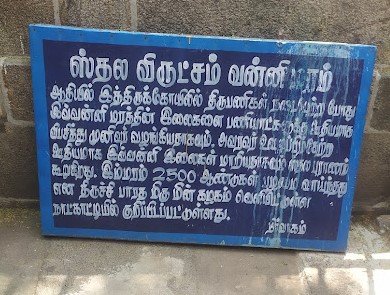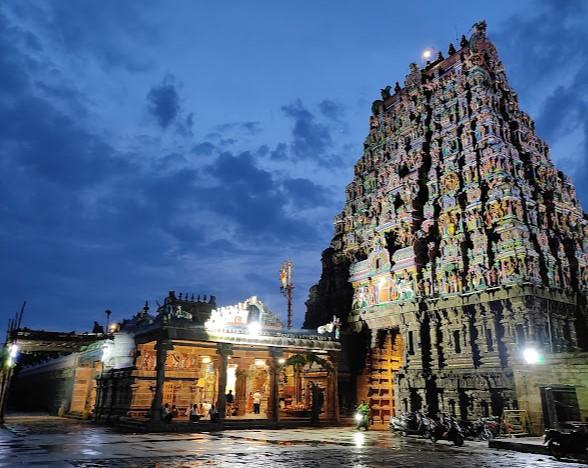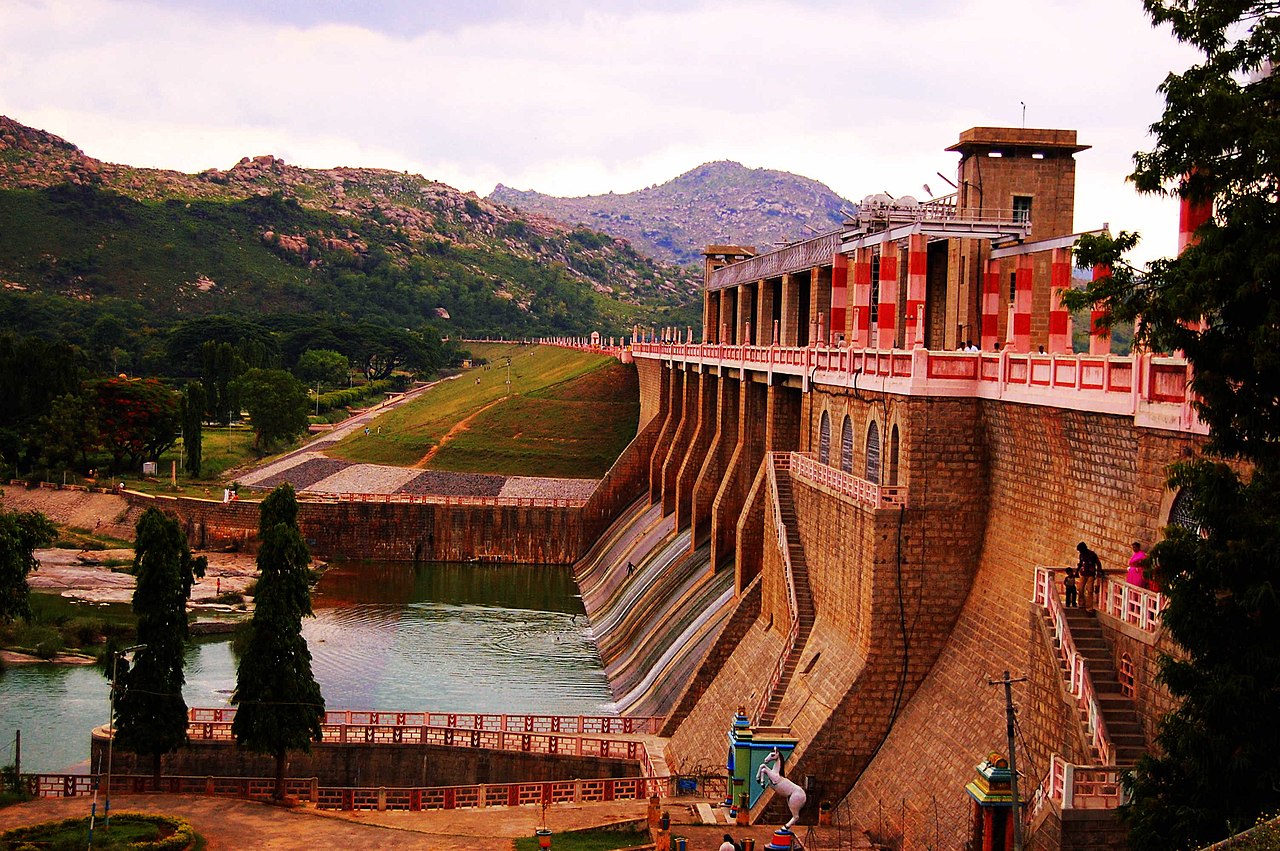Virudhachalam, historically known as Thirumudhukundram before the 6th century, is presently referred to in Sanskrit as Virudhachalam and is also called Virutha Kashi. The temple, located on the banks of the Manimuktha River, holds significant religious importance. It is the 41st Thevara Paadal Petra Shiva Sthalam and the 9th sthalam of Nadu Naadu.
The temple is dedicated to Lord Shiva and is associated with the ancient Chola period. It is believed to have been commissioned by Sembiyan Mahadevi, one of the most powerful queens of the Chola dynasty and a devoted worshipper of Lord Shiva. The innermost structures, including the inner sanctum and the Ardhamandapam, date back to her reign.
An interesting historical note is that the chains for the temple car were donated in 1813 by Charles Hyde, the District Collector of the time.
Vriddhachalam – The Ancient Temple
Survival of Pralayam and Creation by Siva
Vriddhachalam is considered one of the places that survived the pralayam (cosmic dissolution). According to the creation story, Brahma first created water, and during this process, Vishnu killed the demons Madhu and Kaitabha, whose bodies floated in the water. Brahma, not realizing that Siva had taken the form of a mountain, used the remains of the slain demons to create several hills. However, there was a shortage of space, prompting Brahma to seek Siva’s help. Siva gathered the hills, turning them into a single large hill, marking Vriddhachalam as the first or oldest hill, which is why it is also known as Vriddha-Achalam. Since it was created by Siva, He is called Vriddha-Gireeswarar. This temple is considered older than even Kasi, earning the title "Vriddha Kasi."
Meaning of Vriddhachalam
The name "Vriddhachalam" is derived from the Sanskrit words Vriddha (old) and Achala (hill), also corresponding to the ancient Tamil names Mudu-Kundram and Pazha-Malai. The temple is associated with various puranams and has a rich mythological history.
Cosmic Dance of Siva
Vriddhachalam is one of the few temples where Siva is believed to have danced His cosmic dance, not for a contest like in Chidambaram, but for His own pleasure.
Paadal Petra Sthalam
Vriddhachalam is one of the few Paadal Petra Sthalam temples where all three Saivite saints – Appar, Sambandar, and Sundarar – have sung hymns dedicated to Siva. Two interesting stories are associated with Sundarar's visit here.
Sundarar’s Test of Purity of Gold
Sundarar visited the temple and sang pathigams on Siva, receiving 12,000 gold coins to feed the poor. Sundarar, ever keen to test the purity of the gold, had the coins tested by Vinayakar, who served as a witness. To avoid theft, Sundarar threw the coins into the Manimutharu river and later recovered them at Tiruvarur. This event led to the saying, "aatrile pottu, kulathile thedu" (to lose something in the river and search for it in the tank).
Sundarar and Balambika
When the elders asked Sundarar to sing verses dedicated to Parvati, he initially refused, calling her an old woman (Vriddhambigai). To appease him, the elders installed a new murti of Parvati as a young girl, named Balambika, and Sundarar relented, singing hymns dedicated to her.
Stories of Balambika
One story is about Guru Namasivayar, who prayed to Parvati here for food. Parvati initially appeared as an old woman, but upon the sage singing a verse visualizing her as a young woman, she appeared in that form and provided him with food.
In another tale, a starving king from the Karnataka region was fed by Parvati, who took the form of a young woman and named him Kumara Deva.
Sage Vibhasiddhu’s Contribution
According to one sthala puranam, Sage Vibhasiddhu was meditating when a bird dropped a royal earring into his lap. Recognizing it, he returned it to the palace, and in gratitude, the princess gifted him a vast sum of wealth, which he used to build the temple. Another version states that the sage paid laborers with leaves from the temple's Vanni tree, which turned into gold coins.
Arunagirinathar’s Connection
Arunagirinathar, a famous Tamil saint, has sung praises of Murugan at this temple in his work Tiruppugazh.
Importance and Beliefs
Vriddhachalam, associated with Kasi, is believed to grant mukti (salvation) to those who are born, live, worship, or die here. It is said that those who die in this place are blessed by Parvati, who cradles them in her lap, and Siva blesses them by whispering the Panchakshara mantram in their ears, offering direct salvation. The ashes of the departed, when immersed in the Manimutharu river, are said to turn into stone.
Temple Structure and Historical Significance
The temple’s present structure dates back to the Chola period, commissioned by Sembian Madevi, the grandmother of Raja Raja Chola I. She constructed the fifth gopuram, which was named after her husband, Gandaraditya Chola. The temple underwent further renovations by the Pandya kings. The inscriptions found within the temple mostly reference Chola kings such as Parantaka Chola, Gandaraditya Chola, and Raja Raja Chola I, as well as Pandya kings like Sundara Pandyan and Vikrama Pandyan.
Saiva Siddhanta and the 28 Agamas
Saiva Siddhanta, a prominent school of Shaivism, is centered on the worship of Lord Shiva and consists of 28 Agamas, which are sacred texts that guide the rituals, philosophy, and spiritual practices of Shaivism. The Agamas are branches of knowledge that provide a structured way of worship and understanding of the divine.
The 28 Shivalingas Installed by Lord Muruga
Lord Muruga, an important deity in the Tamil Shaiva tradition, is believed to have installed 28 Shivalingas that represent the 28 Agamas. These lingas are located in a special shrine situated northwest of the main temple. It is said that Lord Muruga performed pujas to these Shivalingas, honoring the Saiva Siddhanta philosophy.
Alignment of Deities
Lord Vinayaka: Located along the southern line of the 28 Shivalingas.
Lord Muruga with Consorts: Positioned along the northern line, with Lord Muruga accompanied by His consorts, Valli and Deivanai.
The Names of the 28 Shivalingas
Each of the 28 Shivalingas has a distinct name, representing a specific Agama. The names are as follows:
- Kamikeswarar
- Yogeswarar
- Sindhyeswarar
- Karaneswarar
- Ajitheswarar
- Deepadheswarar
- Sukshmeswarar
- Sahasreswarar
- Amsumaneswarar
- Sapradeswarar
- Vijayeswarar
- Viswaseswarar
- Swayambeswarar
- Analeswarar
- Veereswarar
- Rouravareswarar
- Makudeswarar
- Vimaleswarar
- Chandragnaneswarar
- Mukambireswarar
- Sarvothameswarar
- Parameswarar
- Kiraneswarar
- Vaduleswarar
Agama Temple: A Unique Feature
This temple is referred to as the "Agama Temple" because it uniquely houses the 28 Shivalingas that represent the 28 Agamas, a feature exclusive to this particular temple. The presence of these lingas underscores the temple’s significance as a center for the worship and practice of Saiva Siddhanta.
The Meaning of Vruddhalacham
- Vruddha: Refers to ancient or venerable.
- Achalam: Means hill.
- Vruddhalacham: Refers to an ancient hill, emphasizing the historical and sacred nature of the location.
- Mudhu Kundram: In chaste Tamil, this term is used to describe the hill, as mentioned in Thevaram hymns. "Mudhu" means ancient, and "Kundram" means hill, symbolizing the long-established spiritual significance of the place.
Aazhathu Vinayakar
The main Vinayakar at this temple is located to the left after entering the temple, in a subterranean shrine reached by descending 18 steps, similar to the Kalahasti shrine. This Vinayakar is called Aazhathu Vinayakar, meaning "deep Vinayakar," reflecting his location in the depths.
The Oldest Mountain:
According to Hindu mythology, when Brahma decided to create the earth, he first created water. During this time, Lord Vishnu vanquished the evil Madhukaidavas, and their body parts floated on the water created by Brahma. Seeing this, Brahma prayed to Lord Shiva, asking him to create the earth from the hardened compound formed from the water and the flesh of the bodies. Lord Shiva responded by appearing as a mountain, which Brahma did not initially recognize. He created many mountains, but there was no space for them to exist, and this caused him sorrow.
At that moment, the Pranava God appeared and communicated the truth to Brahma through gestures. Brahma then worshiped Lord Shiva in the form of a mountain. Lord Shiva combined the flesh and water to create the earth, known as "Medhini," and gave space for the mountains created by Brahma. Shiva told Brahma that the mountain he created was not separate from him. This mountain was called Pazha Malai (Old Mountain), and its top layer is believed to appear in the riverbed of Cuddalore at Vayalur, about 4 km north of Virudhachalam. Worshipping this mountain would grant all desires. This mountain is invisible, but its divine essence is present.
Place for Salvation:
Devotees believe that anyone born, living, praying, or even thinking of the Lord in Virudhachalam, or dying in this sacred place, will attain salvation and be freed from the cycle of birth and death.
Virudhachalam Unaffected by Pralaya:
Virudhachalam is said to have remained untouched and fully alive when the world was destroyed by pralaya (the great flood). The place is believed to have withstood the calamity, preserving its holiness.
1008 Shiva Shrines:
Of the 1008 highly esteemed Shiva shrines across the country, Virudhachalam is one of the four that are considered the most sacred.
Etymology of Virudhachalam:
The name "Virudhachalam" is derived from "Vriddha," meaning ancient, and "Achalam," meaning hill. The place was also known as "Pazhamalai" (Old Mountain) in Tamil during the time of the Saivite saints Appar, Gnanasambandhar, and Sundarar. Later, the name transformed into its Sanskrit version, "Virudhachalam."
Sage Vibasithu and the Vanni Tree:

Sage Vibasithu, after taking a dip in the Manimuthar River, undertook the renovation of the Virudhachalam temple. He provided his workers with Vanni tree leaves, which miraculously transformed into coins based on the quality and quantity of the work. The Vanni tree itself is believed to be over 1700 years old.
Mattru Uraitha Vinayaka:
Saint Sundarar, while on a mission to collect funds for the Panguni Uthiram festival in Tiruvarur, passed through Virudhachalam without singing the praises of the Lord. The Lord stopped him, and Sundarar was compelled to sing. Afterward, the Lord donated 12,000 gold coins to Sundarar, who feared robbers on the way. He placed the coins in the Manimuthar River and later retrieved them from a tank in Tiruvarur, defying the natural laws. This miracle led to the phrase, "losing in the river and searching in the tank."
Lord Vinayaka in the inner prakara of the temple is known as Mattru Uraitha Vinayaka, which means "Touch and Confirmed Vinayaka," as he witnessed the miracle of confirming the gold's purity.
Significance of Number Five:
The number five plays a crucial role in this temple:
- Five deities are worshiped: Lord Vinayaka, Muruga, Shiva, Shakti, and Chandikeswara.
- The Lord has five names: Virudhagireeshwarar, Pazhamalai Nathar, Vruddhachaleswarar, Mudhu Kundreeswarar, and Vruddhagiri.
- There are five Vinayakas: Aazhathu Vinayakar, Mattru Uraitha Vinayaka, Muppillayar, Dasabhuja Ganapathy, and Vallabha Ganapathi.
- Five Rishis have had the darshan of the Lord: Romesa, Vibasiddhu, Kumaradeva, Nada Sharma, and Anavardhini.
- Five towers in the temple represent the four directions (east, west, north, south) and a Chola king’s tower (Kandarathithan gopuram).
- The temple has five prakaras: Kailaya, Vanniyadi, 63 Nayanmar Chuttru, Panchavarna Chuttru, and Thiruchutru.
- Five Kodimarams (flag posts) with five Nandhis: Indra Nandhi, Vedha Nandhi, Athma Nandhi, Maalvidai Nandhi, and Dharma Nandhi.
- There are five inner Mandapams: Artha, Idaikazhi, Thapana, Maha, and Isai Mandapams.
- Five times of worship are observed daily: Thiruvanandal, Kalasanthi, Uchi Kala, Sayaraksha, and Arthajama.
Virudha Kasi:
Virudhachalam is considered holier than Varanasi (Kasi), as it is believed that Mother Viruthambigai, in her maternal form, cradles the souls of the departed and ensures their salvation by Lord Shiva chanting the Namasivaya mantra in their ears. This is why it is also known as "Virudhakasi."
Ashes Turning to Stone:
According to the Sthalapuranam, the ashes of the dead, when dissolved in the Manimuthar River, are believed to transform into stone and remain beneath the river.
Mother Peria Nayaki Fed the King of Karnataka:
During his visit, the King of Karnataka suffered from hunger. Mother Peria Nayaki, in her compassionate form, fed him with milk, and thus, she earned the name "Kumara Deva."
Lord Shiva's Dance:
Lord Shiva, as Nataraja, is believed to have danced in Thillai for a contest. However, here in Virudhachalam, he danced solely for his own joy.
Mother's Divine Appearance to Guru Namshivayar:
Guru Namshivayar, traveling through Virudhachalam on his way to Chidambaram, was hungry and called out to the Mother. Initially appearing as an old woman, Mother Periyanayagi responded that only a young woman could provide food. Upon Namshivayar’s praise, she transformed into a youthful and beautiful form and fed him. From then on, she was revered as Balambika, the young Mother.
Maasi Magam Festival:
The Maasi Magam festival is significant in Virudhachalam. It is believed that Sage Vibasithu received the darshan of Lord Shiva and Mother Viruthambigai on the sixth day of the festival.
Story Behind the Construction of the Temple:
The temple's construction is attributed to Sage Vibasithu, who, after finding the earring of Kubera's daughter, returned it to her. In gratitude, she rewarded him with jewelry, which he used to construct the temple. This temple continues to be a beacon of faith for generations of devotees.
ADMINISTRATION:
It is administered under the Hindu Religious and Charitable Endowments (HR&CE) Department of the Government of Tamil Nadu.


